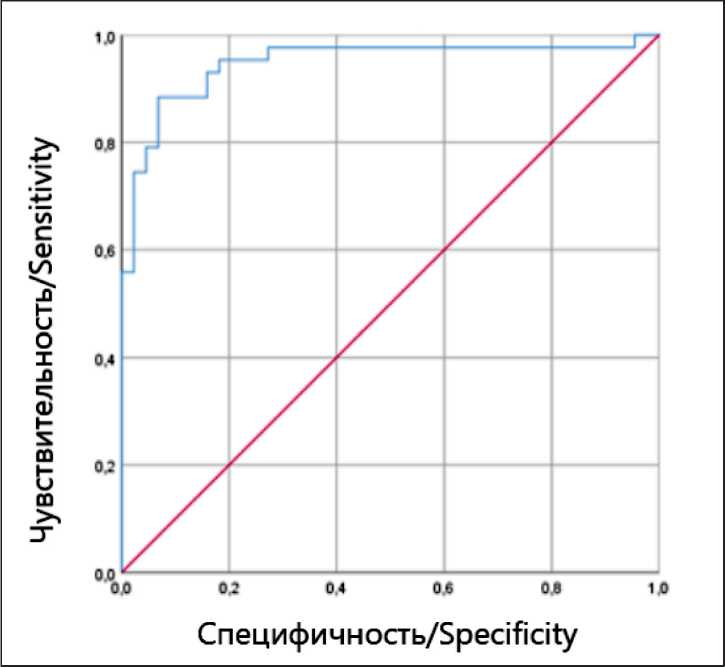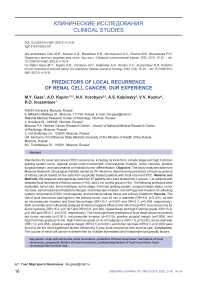Predictors of local recurrence of renal cell cancer. Our experience
Автор: Gaas M.Y., Kaprin A.D., Vorobyev N.V., Kalpinsky A.S., Kozlov V.V., Inozemtsev R.O.
Журнал: Сибирский онкологический журнал @siboncoj
Рубрика: Клинические исследования
Статья в выпуске: 4 т.21, 2022 года.
Бесплатный доступ
Risk factors for renal cell cancer (Rcc) recurrence, including its local form, include stage and high Fuhrman grading system score, regional lymph node involvement, microvascular invasion, tumor necrosis, positive surgical margin, and sarcomatoid or rhabdoid tumor differentiation. Objective. the study analyzes data from moscow Research oncological institute named by pa Herzen to determine the predictors of local recurrence of kidney cancer based on the data from surgically treated patients with local recurrent Rcc. material and methods. We analyzed retrospectively data from 87 patients who were divided into 2 groups: 1-st, patients with detected local recurrence of kidney cancer (n=43), and 2-nd, control group (n=44). the following predictors were evaluated: tumor size, tumor histotype, tumor stage, Fuhrman grading system, surgical margin status, tumor necrosis, sarcomatoid and rhabdoid changes, microvascular invasion, hemorrhage and invasion of collecting system components (css), renal capsule, and perirenal cellular tissue and primary treatment. Results. the risk of local recurrence was higher in the primary tumor, over 40 mm in diameter (oR=5.8, p function show_abstract() { $('#abstract1').hide(); $('#abstract2').show(); $('#abstract_expand').hide(); }
Renal cell carcinoma, local recurrence, predictors of local recurrence, risk factors of local recurrence, prognostic factors of local recurrence, predisposing factors of local recurrence, local recurrence-free survival rate
Короткий адрес: https://sciup.org/140295746
IDR: 140295746 | УДК: 616.61-006.6-037 | DOI: 10.21294/1814-4861-2022-21-4-16-24
Текст научной статьи Predictors of local recurrence of renal cell cancer. Our experience
Objective. The study analyzes data from Moscow Research Oncological Institute named by PA Herzen to determine the predictors of local recurrence of kidney cancer based on the data from surgically treated patients with local recurrent RCC.
Material and Methods
We analyzed retrospectively data from 87 patients who underwent nephrectomy or kidney resection for RCC between 1999 and 2018. Patients of both sexes were included in the study and divided into 2 groups:
-
1, patients with detected local recurrence of kidney cancer (n=43), and 2, control group of patients with relapse-free disease (n=44).
None of the patients received pre- or postoperative therapy. We defined local recurrence as a tumor nodule detected after radical removal of a primary tumor of the same histological type in the bed of the removed tumor after renal resection [5]. A tumor mass in the renal bed [6], as well as involvement of regional lymph nodes and ipsilateral adrenal gland were taken as local recurrence after nephrectomy [7].
Univariate and multivariate Cox regression models were used to identify predictors of recurrence. The p<0.05 was significant. For statistical analysis, local recurrence-free survival (L-RFS) was calculated as the time from surgery to setting of local recurrence of kidney cancer. Statistical analysis was performed using IBM SPSS v.26.0 software. L-RFS was estimated using the Kaplan-Meier method.
Results
We analyzed data from 87 patients operated for renal cell cancer between 2000 and 2018. Table 1 presents the clinical and pathomorphological characteristics of the patients. The study included patients of both sexes. The mean age was 57.6 years (26 to 76 years). The average follow-up period was 8 years (9 months to 20 years). For the underlying disease, patients underwent both surgical and non-surgical treatment. The mean primary tumor size was 56.3 mm (range 10–130 mm). The major histotype was the clear cell RCC in both groups.
Table 2 presents the most frequent locations of local recurrence after major surgery in patients with established local recurrence. In 5 patients undergone radiofrequency ablation for a tumor, 100 % local recurrence occurred in the previously performed ablation, in the tumor itself.
In the study, we also evaluated the effect of the above-described indices on the likelihood of local RCC recurrence. A univariate analysis identified the most likely risk factors for local RCC recurrence. The risk of local recurrence was higher in the primary tumor, over 40 mm in diameter (OR=5.8, p<0.001), as well as the pathomorphological features of microvascular invasion and focal hemorrhage in tumor tissue (OR=15.1, p=0.001 and OR=3.3, p=0.008, respectively). Both single-factor and multivariate analyses showed a negative effect on the risk of local RCC recurrence only for tumor necrosis (OR=15.4, p<0.001 and OR=53.6, p=0.002, respectively) and high Fuhrman grade (OR=10.9, p=0.042 and OR=5.7, p=0.032, respectively). Table 3 presents the results of the comparative analysis.
Stepwise logistic regression algorithm showed the most significant factors for the probability of local RCC recurrence (Table 4). Based on these data, the most significant predictors of local renal cancer recurrence are tumor necrosis (p<0.001), microvascular invasion (p=0.019), positive surgical margin (p=0.009), and high Fuhrman grade (p=0.04).
Based on these results, we created a prognostic model (Fig. 1) and found a significant effect of the above criteria on the probability of local recurrence of kidney cancer (AUC=0.947). Logistic regression was performed with stepwise inclusion of predictors. Model parameters: Sensitivity 83.7 %, Specificity 90.9 %, R2=0.656. The significance of the model is p˂0.001, χ2 = 58 922.
The next step was to assess the effect of the criteria on the 5-year local recurrence-free survival (L-RFS)

Fig. 1. ROС-сurve
Рис. 1. ROС-кривая
Table 1/Òàблицà 1
Note: BMI – body mass index; RFTA – radiofrequency thermoablation; ccRCC – clear cell renal cell carcinoma; CCC – collecting system components; PSM – positive surgical margin; NSM – negative surgical margin.
The clinical and pathomorphological characteristics
Êлиничåñêиå и пàтîмîðфîлîгичåñêиå дàнныå пàциåнтîв
Список литературы Predictors of local recurrence of renal cell cancer. Our experience
- Shuch B.M., Lam J.S., Belldegrun A.S., Figlin R.A. Prognostic factors in renal cell carcinoma. Semin Oncol. 2006; 33(5): 563-75. doi: 10.1053/j.seminoncol.2006.06.006.
- NguyenD.P., VertosickE.A., CorradiR.B., Vilaseca A., BenfanteN.E., Touijer K.A., Sjoberg D.D., Russo P. Histological subtype of renal cell carcinoma significantly affects survival in the era of partial nephrectomy. Urol Oncol. 2016; 34(6). doi: 10.1016/j.urolonc.2016.01.005.
- Patard J.J., LerayE., Rioux-LeclercqN., CindoloL., Ficarra V., Zis-man A., De La Taille A., Tostain J., Artibani W., Abbou C.C., Lobel B., Guillé F., Chopin D.K., Mulders P.F., Wood C.G., Swanson D.A., Figlin R.A., Belldegrun A.S., Pantuck A.J. Prognostic value of histologic subtypes in renal cell carcinoma: a multicenter experience. J Clin Oncol. 2005; 23(12): 2763-71. doi: 10.1200/JC0.2005.07.055.
- Leibovich B.C., Lohse C.M., Crispen P.L., Boorjian S.A., Thompson R.H.,BluteM.L., Cheville J.C. Histological subtype is an independent predictor of outcome for patients with renal cell carcinoma. J Urol. 2010; 183(4): 1309-15. doi: 10.1016/j.juro.2009.12.035.
- Wood E.L., Adibi M., Qiao W., Brandt J., Zhang M., Tamboli P., Matin S.F., WoodC.G., Karam J.A. Local Tumor Bed Recurrence Following Partial Nephrectomy in Patients with Small Renal Masses. J Urol. 2018; 199(2): 393-400. doi: 10.1016/j.juro.2017.09.072.
- Kriegmair M.C., Bertolo R., Karakiewicz P.I., Leibovich B.C., Ljungberg B., Mir M.C., Ouzaid I., Salagierski M., Staehler M., van Poppel H., Wood C.C., Capitanio U.; Young Academic Urologists Kidney Cancer working group ofthe European Association of Urology. Systematic Review of the Management of Local Kidney Cancer Relapse. Eur Urol Oncol. 2018; 1(6): 512-23. doi: 10.1016/j.euo.2018.06.007.
- Margulis V., McDonaldM., Tamboli P., Swanson D.A., Wood C.G. Predictors of oncological outcome after resection of locally recurrent renal cell carcinoma. J Urol. 2009; 181(5): 2044-51. doi: 10.1016/j. juro.2009.01.043.
- Barbas Bernardos G., Herranz Amo F., Caño Velasco J., Cancho Gil M.J., Mayor de Castro J., Aragón Chamizo J., Polanco Pujol L., Hernández Fernández C. Influence of venous tumour extension on local and remote recurrence of stage pT3a pN0 cM0 kidney tumours. Actas Urol Esp (Engl Ed). 2019; 43(2): 77-83. doi: 10.1016/j.acuro.2018.06.007.
- Crispen P.L., Boorjian S.A., Lohse C.M., Sebo T.S., Cheville J.C., Blute M.L., Leibovich B.C. Outcomes following partial nephrectomy by tumor size. J Urol. 2008; 180(5): 1912-7. doi: 10.1016/j.juro.2008.07.047.
- Andrews J.R., Atwell T., Schmit G., Lohse C.M., Kurup A.N., Weisbrod A., Callstrom M.R., Cheville J.C., Boorjian S.A., Leibovich B.C., Thompson R.H. Oncologic Outcomes Following Partial Nephrectomy and Percutaneous Ablation for cT1 Renal Masses. Eur Urol. 2019; 76(2): 244-51. doi: 10.1016/j.eururo.2019.04.026.
- Minervini A., Campi R., Sessa F., Derweesh I., Kaouk J.H., Mari A., Rha K.H., Sessa M., Volpe A., Carini M., Uzzo R.G. Positive surgical margins and local recurrence after simple enucleation and standard partial nephrectomy for malignant renal tumors: systematic review of the literature and meta-analysis of prevalence. Minerva Urol Nefrol. 2017; 69(6): 523-38. doi: 10.23736/S0393-2249.17.02864-8.
- Bernhard J.C., Pantuck A.J., WallerandH., CrepelM., Ferriere J.M., BellecL., Maurice-Tison S., Robert G., Albouy B., Pasticier G., SoulieM., Lopes D., LacroixB., Bensalah K., Pfister C., ThuretR., Tostain J., De La TailleA., SalomonL., Abbou C., ColombelM., BelldegrunA.S., Patard J.J. Predictive factors for ipsilateral recurrence after nephron-sparing surgery in renal cell carcinoma. Eur Urol. 2010; 57(6): 1080-6. doi: 10.1016/j. eururo.2010.02.019.
- Shah P.H., Moreira D.M., Okhunov Z., Patel V.R., Chopra S., RazmariaA.A., AlomM., GeorgeA.K., Yaskiv O., SchwartzM.J., DesaiM., ViraM.A., Richstone L., Landman J., Shalhav A.L., Gill I., Kavoussi L.R. Positive Surgical Margins Increase Risk of Recurrence after Partial Nephrectomy for High Risk Renal Tumors. J Urol. 2016; 196(2): 327-34. doi: 10.1016/j.juro.2016.02.075.
- 14.MarchinenaP.G., TirapeguiS., GonzalezI.T., Jurado A., Gueglio G. Positive surgical margins are predictors of local recurrence in conservative kidney surgery for pT1 tumors. Int Braz J Urol. 2018; 44(3): 475-82. doi: 10.1590/S1677-5538.IBJU.2017.0039.
- Abu-Ghanem Y., Ramon J., Berger R., Kaver I., Fridman E., Leiboowitz-Amit R., Dotan Z.A. Positive surgical margin following radical nephrectomy is an independent predictor of local recurrence and disease-specific survival. World J Surg Onc 15. 2017. doi: 10.1186/ s12957-017-1257-6.
- BertoloR., NicolasM., Garisto J., Magi-Galluzzi C., McKenney J.K., Kaouk J. Low Rate of Cancer Events After Partial Nephrectomy for Renal Cell Carcinoma: Clinicopathologic Analysis of 1994 Cases with Emphasis on Definition of «Recurrence». Clin Genitourin Cancer. 2019; 17(3): 209-215. doi: 10.1016/j.clgc.2019.03.004.
- Chen X.S., Zhang Z.T., Du J., Bi X.C., Sun G., Yao X. Optimal surgical margin in nephron-sparing surgery for T1b renal cell carcinoma. Urology. 2012; 79(4): 836-9. doi: 10.1016/j.urology.2011.11.023.
- Oh J.J., Byun S.S., Lee S.E., Hong S.K., Lee E.S., Kim H.H., Kwak C., Ku J.H., Jeong C.W., Kim Y.J., Kang S.H., Hong S.H. Partial nephrectomy versus radical nephrectomy for non-metastatic pathological T3a renal cell carcinoma: a multi-institutional comparative analysis. Int J Urol. 2014; 21(4): 352-7. doi: 10.1111/iju.12283.
- CorreaA.F., Jegede O., HaasN.B., FlahertyK.T., PinsM.R., Messing E.M., Manola J., Wood C.G., Kane C.J., JewettM.A.S., Dutcher J.P., DiPaolaR.S., CarducciM.A., UzzoR.G. Predicting Renal Cancer Recurrence: Defining Limitations of Existing Prognostic Models With Prospective Trial-Based Validation. J Clin Oncol. 2019; 37(23): 2062-71. doi: 10.1200/JC0.19.00107.


